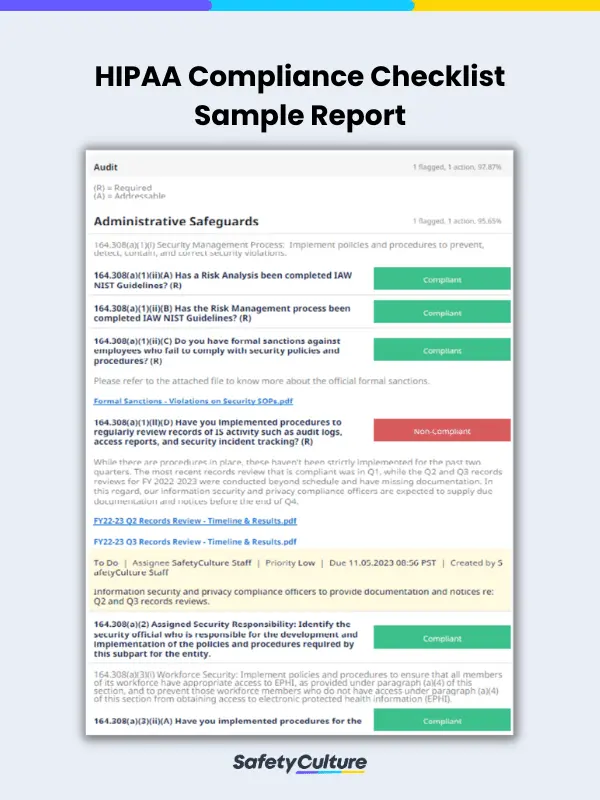What is a HIPAA Compliance Checklist?
A HIPAA compliance checklist is a tool that helps institutions and their associates who handle Protected Health Information (PHI) stay compliant with the Health Insurance Portability and Accountability Act (HIPAA). HIPAA is a US law that requires the careful handling of PHI or individually identifiable health information. Violation of HIPAA can lead to costly fines and legal action.
Biggest Causes of HIPAA Breach
HIPAA breaches can happen due to a number of reasons, including the following:
- Unintentional error – This refers to instances wherein medical practitioners disclose medical conditions and sensitive patient information to the wrong person. It also covers situations where unsecured medical documents can be easily accessed by unauthorized people.
- Cyberattacks – Cases of hacking, ransomware, or malware can compromise information security and expose massive sensitive data containing individually identifiable health information leading to millions of dollars in settlement.
- Lost/stolen device – Lost or stolen laptops, USBs, or handheld devices can lead to unauthorized access to electronic PHI (ePHI). Devices with proper encryption of PHI can help avoid HIPAA breaches.
- Unauthorized disclosure/access – exposing PHI to inappropriate avenues or not correcting unauthorized access can be costly if not addressed appropriately.
Why Use a Checklist For HIPAA Compliance
It’s important to note that vulnerabilities and new threats to the security of PHI need to be addressed to stay HIPAA compliant. This is why using a HIPAA compliance checklist is highly recommended.
Apart from that, the following are some of the benefits organizations can achieve from using one:
- Ensuring in-depth and streamlined coverage – Since HIPAA regulations are complex, a checklist can help provide a structured approach to ensure comprehensive coverage of all relevant requirements.
- Identifying potential gaps – A checklist helps identify any gaps in compliance that may exist in an organization’s policies, procedures, and practices to address them toward full compliance.
- Providing a standardized approach – It provides a standardized format for HIPAA compliance that can be used consistently across an organization.
- Facilitating audits and assessments – Also, HIPAA compliance checklists can help provide a clear record of an organization’s compliance activities to demonstrate to auditors that the necessary PHI protection safeguards are in place.
What to Include in a HIPAA Compliance Checklist
To help make your HIPAA compliance template comprehensive, make sure to include the following elements and sections:
- Introduction or Title Page – includes the institution name, location, date of the compliance check, and compliance auditor name
- Sections for Administrative, Physical, and Technical Safeguards – multiple-choice questions to check if such are compliant, non-compliant, or not applicable to the organization’s policies and procedures
- Completion Page – section to put comments, recommendations, and auditor sign-off
How to Stay HIPAA-Compliant with the Help of Checklists
Avoid HIPAA violations with these straightforward tips:
Start with Human Resources (HR).
Recruit the right staff, conduct background checks, and provide the proper training on handling patient information. Keep your staff updated about new risks to information security.
Evaluate the compliance of staff and partners.
Check the practices of staff and vendors handling PHI. Reinforce HIPAA-compliant practices by conducting audits (per HIPAA) and observing staff while on the job. Ask vendors for evidence of HIPAA compliance.
Set up access controls.
Establish physical safeguards for access to information and implement encryption of PHI to mitigate the risk of an information breach. Also, make sure that your IT team is always updated about threats and that the systems in place are prepared for cyberattacks.
Conduct security risk assessments.
Institutions and their staff are constantly exposed to new threats to information security. Hence, conducting regular security risk assessments can help identify and immediately mitigate new and evolving risks to prevent costly HIPAA breaches from taking place.
FAQs About HIPAA Compliance Checklist
The main key to HIPAA compliance is the implementation of appropriate administrative, physical, and technical safeguards to protect the confidentiality, integrity, and availability of Protected Health Information (PHI). Organizations must follow strict measures to ensure this is maintained and kept in check.
The three main rules under HIPAA policies and procedures are HIPAA Privacy, Security, and Breach Notification Rules. These rules encompass and apply to different functions of healthcare toward helping organizations maintain HIPAA compliance and uphold their accountability.
HIPAA compliance checklists are used by a variety of entities, including healthcare providers, health plans, and healthcare clearinghouses. Business associates, regulatory agencies, and organizations use HIPAA compliance checklists to assess their level of compliance with the HIPAA rules.
The 5 steps toward HIPAA compliance are:
- Identify and assess potential risks and vulnerabilities to PHI and evaluate the likelihood and impact of a breach.
- Develop and implement policies and procedures that address the identified risks and vulnerabilities.
- Train all employees who have access to PHI on HIPAA regulations, the organization’s policies and procedures, and the importance of protecting PHI.
- Implement technical safeguards to secure PHI, such as encryption, access controls, and backups, and physical safeguards such as secure storage and disposal of records.
- Regularly review and update policies, procedures, and security measures to ensure they remain effective and compliant with HIPAA regulations.


